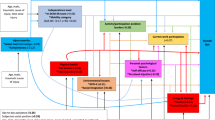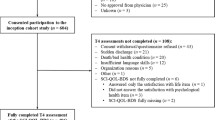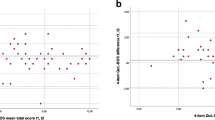Abstract
Study design
International Classification of Functioning, Disability and Health (ICF) linking study.
Objective
Analyze cognitive interview data using the ICF as an analytic framework, to examine aspects of social life relevant to quality of life (QoL) according to people with spinal cord injury or disease (SCI/D). This study builds upon results of an international study about the cross-cultural validity of the International SCI QoL Basic Data Set (QoL-BDS).
Setting
Four specialized outpatient clinics in SCI/D rehabilitation, from the US, Brazil and Australia.
Methods
Analysis of qualitative data from 39 cognitive interviews with SCI/D patients at least one year post onset. Participants were asked to define their concept of QoL, overall life satisfaction, physical health and psychological health, and other relevant matters. Four independent researchers coded text fragments related to the items, and fragments were linked to ICF chapters d6–d9, following established linking rules.
Results
The proportion of text referring to social life was 35.8% (definition QoL), 24.9% (QoL life as whole), 6.0% (physical health) and 34.9% (psychological health). The most frequent ICF categories were d760 Family relationships, d770 Intimate relationships and d920 Recreation and leisure. Most frequent responded social topics to the ‘other issues’ item were d770 Intimate relationships, d760 Formal relationships, and d870 Economic self-sufficiency.
Conclusion
The importance of social life aspects to the QoL was highlighted based on responses of SCI/D patients, clearly demonstrated through the ICF linking process. Adding a satisfaction with social life item to the QoL-BDS has made this instrument a more comprehensive measure.
This is a preview of subscription content, access via your institution
Access options
Subscribe to this journal
Receive 12 print issues and online access
$259.00 per year
only $21.58 per issue
Buy this article
- Purchase on Springer Link
- Instant access to full article PDF
Prices may be subject to local taxes which are calculated during checkout
Similar content being viewed by others
Data availability
The data analyzed during the current study are available from the corresponding author on reasonable request.
References
Kirshblum S, Lin V. Spinal cord medicine. New York: Springer Publishing Company, 2018.
Halvorsen A, Pape K, Post MWM, Biering-Sørensen F, Mikalsen S, Nupen Hansen A, et al. Participation and quality of life in persons living with spinal cord injury in Norway. J Rehabil Med. 2021;53:jrm00217.
Bickenbach J, Officer A, Shakespeare T, von Groote P. International perspectives on spinal cord injury. In: Jerome Bickenbach, editors, Genève: World Health Organization, 2013.
Wood-Dauphinee S, Exner G, Bostanci B, Exner G, Glass C, Jochheim KA, et al. Quality of life in patients with spinal cord injury—basic issues, assessment, and recommendations. Restor Neurol Neurosci. 2002;20:135–49.
Charlifue S, Post MW, Biering-Sorensen F, Catz A, Dijkers M, Geyh S, et al. International spinal cord injury quality of life basic data set. Spinal Cord. 2012;50:672–5.
Amsters D, Schuurs S, Pershouse K, Power B, Harestad Y, Kendall M, et al. Factors which facilitate or impede interpersonal interactions and relationships after spinal cord injury: a scoping review with suggestions for rehabilitation. Rehabil Res Pr. 2016;2016:9373786.
Svenningsen H. Associations between sedation, delirium and posttraumatic stress disorder and their impact on quality of life and memories following discharge from an intensive care unit. Dan Med J. 2013;60:B4630.
Post MWM, Van Leeuwen CMC. Psychosocial issues in spinal cord injury: a review. Spinal Cord. 2012;50:382–9.
Simpson LA, Eng JJ, Hsieh JTC, Wolfe DL. The health and life priorities of individuals with spinal cord injury: a systematic review. J Neurotrauma. 2012;29:1548–55.
Kunz S, Carrard V, Galvis Aparicio M, Scheel-Sailer A, Fekete C, Lude P, et al. Longitudinal measurement invariance of the international spinal cord injury quality of life basic data set (SCI-QoL-BDS) during spinal cord injury/disorder inpatient rehabilitation. Qual Life Res. 2022;31:1247–56.
Hill MR, Noonan VK, Sakakibara BM, Miller WC. Quality of life instruments and definitions in individuals with spinal cord injury: a systematic review. Spinal Cord. 2010;48:438–50.
Rohn EJ, Hakbijl-van der Wind AJ, Post MWM, Forchheimer M, Charlifue S, New PW, et al. A cross-cultural mixed methods validation study of the spinal cord injury quality of life basic dataset (SCI QoL-BDS). Spinal Cord. 2022;60:177–86. 1–10
Post MWM, Adriaansen JJE, Charlifue S, Biering-Sørensen F, Van Asbeck FWA. Good validity of the international spinal cord injury quality of life basic data set. Spinal Cord. 2016;54:314–8.
New P, Tate D, Forchheimer M, Greve J, Parashar D, Post M. Preliminary psychometric analyses of the international spinal cord injury quality of life basic data set. Spinal Cord. 2019;57:789–95.
Nachtegaal J, van Langeveld SA, Slootman H, Post MWM, Society D-FSC. Implementation of a standardized dataset for collecting information on patients with spinal cord injury. Top Spinal Cord Inj Rehabil. 2018;24:133–40.
Post M, Fellinghauer C, Charlifue S, New P, Forchheimer M, Tate D. Rasch analysis Qol-BDS V1.0 and V2.0. Arch Phys Med Rehabil. 2022;103:2120–30.
Chang FH, Liu CH, Hung HP. An in-depth understanding of the impact of the environment on participation among people with spinal cord injury. Disabil Rehabil. 2018;40:2192–9.
Barclay L, Mcdonald R, Lentin P, Bourke-Taylor H. Facilitators and barriers to social and community participation following spinal cord injury. Aust Occup Ther J. 2016;63:19–28.
World Health Organization [WHO]. International classification of functioning, disability and health: ICF. Geneva, Geneva: WHO; 2001.
Eremenco SL, Cella D, Arnold BJ. A comprehensive method for the translation and cross-cultural validation of health status questionnaires. Eval Health Prof. 2005;28:212–32.
Ryan K, Gannon-Slater N, Culbertson MJ. Improving survey methods with cognitive interviews in small-and medium-scale evaluations. Am J Eval. 2012;33:414–30.
Cieza A, Fayed N, Bickenbach J, Prodinger B. Refinements of the ICF Linking Rules to strengthen their potential for establishing comparability of health information. Disabil Rehabil. 2019;41:574–83.
Whiteneck G, Dijkers MP. Difficult to measure constructs: conceptual and methodological issues concerning participation and environmental factors. Arch Phys Med Rehabil. 2009;90:22–35.
Ruoranen K, Post MWM, Juvalta S, Reinhardt J. Participation and integration from the perspective of persons with spinal cord injury from five European countries. J Rehabil Med. 2015;47:216–22.
Levasseur M, Richard L, Gauvin L, Raymond É. Inventory and analysis of definitions of social participation found in the aging literature: proposed taxonomy of social activities. Soc Sci Med. 2010;71:2141–9.
Chang FH, Coster WJ, Helfrich CA. Community participation measures for people with disabilities: a systematic review of content from an international classification of functioning, disability and health perspective. Arch Phys Med Rehabil. 2013;94:771–81.
Magasi S, Post MW. A comparative review of contemporary participation measures’ psychometric properties and content coverage. Arch Phys Med Rehabil. 2010;91:17–28.
Post MW, Charlifue S, Biering-Sørensen F, Catz A, Dijkers MP, Horsewell J, et al. Development of the international spinal cord injury activities and participation basic data set. Spinal Cord. 2016;54:530–4.
Dijkers M. Quality of life after spinal cord injury: a meta analysis of the effects of disablement components. Spinal Cord. 1997;35:829–40.
Cieza A, Geyh S, Chatterji S, Kostanjsek N, Ustün B, Stucki G. ICF linking rules: an update based on lessons learned. J Rehabil Med. 2005;37:212–8.
Piškur B, Daniëls R, Jongmans MJ, Ketelaar M, Smeets RJ, Norton M, et al. Participation and social participation: are they distinct concepts? Clin Rehabil. 2014;28:211–20.
Kang Y, Ding H, Zhou H, Wei Z, Liu L, Pan D, et al. Epidemiology of worldwide spinal cord injury: a literature review. J Neurorestoratology. 2018;6:3.
Jensen MP, Smith AE, Bombardier CH, Yorkston KM, Miró J, Molton IR. Social support, depression, and physical disability: age and diagnostic group effects. Disabil Health J. 2014;7:164–72.
Acknowledgements
The authors thank all participants for their invaluable information about their stories, insights and experiences. Further, we thankfully acknowledge the contributions by the local research team members across the sites for their tireless assistance. Ann Arbor: Constance Pines and Christopher Graves; Denver: Jennifer Coker, Abby Welch, and Bria MacIntyre; Melbourne: Diana Ramirez Hernandez, São Paulo: Angelica Castilho, Alexandra Cristoffi, and Carle Witter.
Funding
This work was supported with a grant from the Craig H Neilsen Foundation, California, USA, grant application ID number 440840.
Author information
Authors and Affiliations
Contributions
AH contributed to study design, led qualitative data analysis, and wrote the manuscript. ER contributed to study design and revisions of the manuscript. CL contributed data analysis and revisions of the manuscript. MF developed Table 1 and contributed to revisions of the manuscript. JS, DT, SC and PN contributed to revisions of the manuscript. MP contributed to study design and revisions of the manuscript.
Corresponding author
Ethics declarations
Competing interests
The authors declare no competing interests.
Ethical approval
The research protocol was approved by the University of Michigan Medical School Institutional Review Board, protocol numbers HUM00126164 and HUM00125769 and the HCA HealthONE Institutional Review Board for Craig Hospital, protocol number 1036454-11. For Brazil, the research protocol was approved by the Medical Ethics Committee of the Hospital das Clínicas da Faculdade de Medicina da Universidade de São Paulo in April 2018. Approbation number CAAE:283112917.3.0000.0068. For Australia, the project was approved by the Alfred Hospital Ethics Committee on 14 June 2017 (project no. 203/17). We certify that all applicable institutional and governmental regulations concerning the ethical use of human volunteers were followed during the course of this research.
Additional information
Publisher’s note Springer Nature remains neutral with regard to jurisdictional claims in published maps and institutional affiliations.
Supplementary information
Rights and permissions
Springer Nature or its licensor (e.g. a society or other partner) holds exclusive rights to this article under a publishing agreement with the author(s) or other rightsholder(s); author self-archiving of the accepted manuscript version of this article is solely governed by the terms of such publishing agreement and applicable law.
About this article
Cite this article
Hakbijl-van der Wind, A.J., Rohn, E.J., Tate, D.G. et al. The social dimension of quality of life following spinal cord injury or disease: an international ICF-linking study. Spinal Cord 62, 104–109 (2024). https://doi.org/10.1038/s41393-023-00954-7
Received:
Revised:
Accepted:
Published:
Issue Date:
DOI: https://doi.org/10.1038/s41393-023-00954-7



